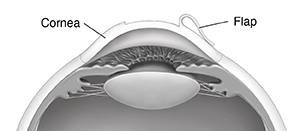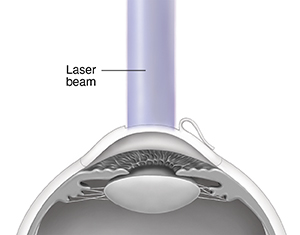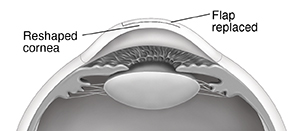A
B
C
D
E
F
G
H
I
J
K
L
M
N
O
P
Q
R
S
T
U
V
W
X
Y
Z
Click a letter to see a list of medical procedures beginning with that letter.
Click 'Back to Intro' to return to the beginning of this section.
Refractive Surgery: LASIK
LASIK stands for laser in-situ keratomileusis. It's a technique for reshaping the cornea. It helps you see better without glasses or corrective lenses. This procedure uses an excimer laser that makes a concentrated beam of ultraviolet (UV) light. Each pulse of the laser can remove a tiny part of corneal tissue. LASIK can be used to correct the following conditions:
What to expect during the procedure
-
Before treatment, you may be given medicine to help you relax.
-
Eye drops numb your eyes. A device is used to keep your eyes open.
-
You may feel pressure, but no pain, as your surgeon makes the flap in the top layer of your cornea (epithelium). The flap is folded back but stays attached to the cornea.
-
Your surgeon uses a computer-guided excimer laser to reshape the cornea. The laser treatment part of the procedure lasts for 10 to 90 seconds.
-
The flap is put back into place. The corneal tissue sticks to itself while it heals.
-
Eye shields are placed over your eyes to protect the flap while it heals.
-
After treatment, your vision will start to get better right away. It should become stable in 1 to 3 months.



When to call your healthcare provider
Call your healthcare provider right away if you have any of these:
-
Fever of 100.4°F (38.0°C) or higher, or as directed by your provider
-
Severe pain
-
Decreased eyesight
-
Symptoms that get worse or don't get better with treatment
-
New symptoms
Pros of LASIK
-
Little or no pain after surgery
-
Fast recovery
-
Very accurate, even for severe refractive problems
-
Serious haze after surgery unlikely
-
Structure of cornea stays intact
Cons of LASIK
-
Risk of flap complications, infection, or inflammation
-
Risk of blurred or distorted vision
-
Possible short-term (temporary) or long-lasting (permanent) dry eye
-
Risk of night vision problems, such as halos, glare, or starbursts
-
Possible undercorrection or overcorrection
-
Possible loss of your best corrected vision
Online Medical Reviewer:
Chris Haupert MD
Online Medical Reviewer:
Tara Novick BSN MSN
Online Medical Reviewer:
Tennille Dozier RN BSN RDMS
Date Last Reviewed:
12/1/2022
© 2000-2024 The StayWell Company, LLC. All rights reserved. This information is not intended as a substitute for professional medical care. Always follow your healthcare professional's instructions.